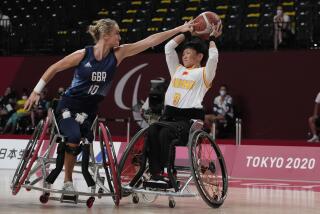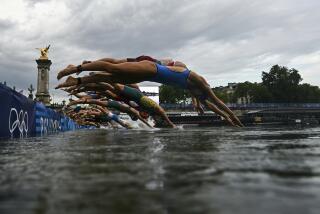RUNNING ON EMPTY : Triathletes Are All Too Often Unaware of Dangers They Face
- Share via
On the morning of June 28, C. Frederick Kelley, 61, successfully swam one-third of a mile, completing the first leg of the Farmington triathlon in Canton, Conn.
The school superintendent climbed out of the Farmington River’s 58-degree water and, as he headed toward his bicycle, went into cardiac arrest. Two hours later, despite repeated attempts to revive him, Kelley was dead.
On that same Sunday morning, Steven McAdams, 30, had already completed a 600-meter swim and was well into the biking segment of the Governor’s Cup triathlon in Boulder, Colo.
As McAdams tried to pass another cyclist, their wheels tangled. McAdams spun out of the coned-off bike lane and into the path of automobile traffic. He was hit by a pickup truck and killed instantly.
Triathlon participants and promoters have called the events of the last Sunday in June unfortunate coincidences, flukes. Kelley had a history of heart trouble, they point out. Both races were well marshaled. The Governor’s Cup was sanctioned by Triathlon Federation USA (Tri-Fed), the governing body of the sport.
But the two fatalities have added to a growing number of triathlon-related deaths and injuries:
--On July 26, a 15-year old Los Angeles girl was struck by a car and killed while competing in the eighth annual San Luis Obispo recreation triathlon. During the bike race, she failed to check for automobiles while crossing a county highway.
--On June 14, Dr. Seymour Leebowitz, 50, died of a heart attack less than a minute after mounting his bike in the Sprint triathlon in Craigville Beach, Mass., another event sanctioned by Tri-Fed.
--On July 12, Yonezo Kasahara, 39, drowned in rough waters in the Miyako Jima triathlon in Hirara, Japan. Another person was listed as missing when his boat, sent to rescue Kasahara, capsized.
--Last September, Paul Childs, 20, collided with a car in an intersection during the bicycle portion of a triathlon in Kansas City, Mo., and was killed.
--Last August, David Daniels, 25, drowned in a Muskegon, Mich., triathlon the morning before he was to have graduated from Grand Valley State College in Allendale, Mich.
The people involved in those incidents represent only a few of the 700,000 to 1 million triathletes who Triathlete magazine says will compete this year in almost 2,000 of the swim-bike-run events.
But as the sport continues its phenomenal growth--five years ago, there were only 10,000 triathletes--the safety issue grows along with it.
“There is a need to alert people that triathlons are fairly serious undertakings that require sober thought and commitment,” said Dr. Derrik Woodbury, an orthopedic surgeon in Bloomfield, Conn., and the partner of the late Dr. Leebowitz.
Triathlon safety raises “definite areas of concern,” according to Dr. Glenn Town, an exercise physiologist at Wheaton College in Wheaton, Ill., and the author of a book on triathlon training. The concerns come down largely to who the competitors are and how the contests are run.
When questioned about safety, triathletes are quick to point out that accidents occur in all sports.
But in the last two years, there have been no fatalities in nearly 2,500 bike races sanctioned by the United States Bicycling Federation.
U.S. Swimming has recorded no fatalities in its sanctioned events, which include rough-water swims.
Four heart attacks have been reported in the last 18 months in the more than 10,000 track and field and road-race events sanctioned by The Athletics Congress.
Because of the range of locations, conditions, and levels of competition, safety and fitness requirements vary from triathlon to triathlon, not only in the 400 events governed by Tri-Fed, but in hundreds of independent competitions as well.
Triathlons have been held for more than a decade, but it wasn’t until 1982 that they caught the public’s imagination. Viewers of ABC’s “Wide World of Sports” watched Julie Moss of Carlsbad dramatically finish the Ironman in Hawaii. After completing a 2.4-mile swim, a 112-mile bike ride and almost all of the marathon run, Moss collapsed.
Kathleen McCartney passed her and took first place in the women’s division but Moss completed the race, crawling across the finish line.
Triathlons thus came to be seen as the ultimate challenge, the competition to end all competitions.
“I think the sport suffers from the gruel-athon image of the Ironman,” said Cathy Plant, public relations director for Encinitas-based CAT Sports, which produces the 13-race Bud Light U.S. Triathlon Series (USTS).
Most triathlons are much shorter than the Ironman, including USTS races, which include a 1.5-kilometer swim, less than a mile; a 40-kilometer bike race, about 25 miles, and a 10-kilometer run, just more than 6 miles.
Scott Tinley, the sport’s dominant professional, says that the intimidating image of triathlons can have positive effects.
“I think people are in awe of them and at least prepare themselves adequately enough to finish,” he said.
According to Terry Mulgannon of Triathlete magazine, the average triathlete is a college-educated male between 30 and 50 whose professional life is characterized by success.
Verne Scott, executive director of Tri-Fed, estimates that more than 50% of triathletes competing annually are first-timers.
Said Thomas Cooney, race director for the Chicago triathlon: “You get a lot of these macho men who want to do the Ironman type of thing. They don’t train, but they want to go back to the bar and brag about it.”
Almost all triathlons require competitors to sign a waiver before participating, saying they are competing at their own risk, and most race directors and promoters say that screening of physical condition is logistically impossible.
“You get to the point of over-regulation and over-administration,” said Carl Thomas, president of CAT Sports. “This isn’t the Army. We’re not drafting people.”
Some race directors, however, have begun screening. The Chicago USTS and the Chicago triathlon--held July 26 and Aug. 2, respectively--draw nearly 6,000 triathletes and require entrants to prove that they have either completed at least one triathlon or have passed the inspection of a water-safety instructor.
“It’s not that difficult,” said Cooney of the certification process. “It weeds out maybe only 20 or 30 people. But what it does is make people aware that there is some element of danger.”
Richard Cotton, the chief exercise physiologist at Scripps Clinic Sports Medicine Center in San Diego, and Alan Halling, the center’s director, suggest that race directors question competitors older than 45 about risk factors, such as high blood pressure, cholesterol and diabetes.
“But it’s not necessarily the inexperienced who get in trouble,” warned Dr. Doug Hiller, USTS medical adviser.
Course conditions and management also are large factors in safety.
Liz Bulman, a top professional from Columbia, Mo., learned the hazards the hard way.
Last September, Bulman was with the lead pack of cyclists at the USTS championship event in Hilton Head, S.C., when a car, allowed through an intersection by a course marshal, stopped in her path. Two other cyclists hit the car and Bulman hit one of the downed cyclists, falling herself and injuring her shoulder and knee. She says she still has not fully recovered.
“A lot of the courses I’ve seen have been unsafe,” Bulman said. “There needs to be more education of the course marshals.”
Most triathlons use local law enforcement officials to monitor intersection traffic during gaps between cyclists and runners. Courses completely closed off from traffic--such as the city-sponsored Carlsbad triathlon--are rare.
“The safest bike course is completely closed off,” said Jake Moe, the race director of the Miller Lite triathlon in Seattle. “But you usually can’t have that. The police bills are too high.”
Because of the unique needs of a triathlon course--proximity to a body of water and adequate courses for both biking and running--cooperation from city officials and community groups is critical to an event’s success. Last June, the Orange County USTS triathlon was switched to a swim-run biathlon because the community of Laguna Niguel objected to closing roads, even partially, for the bike portion.
“Ensuring the safety antagonized the whole neighborhood,” said Tom Riley, supervisor of Orange County’s fifth district.
Said Mike McCullough, race director of the Governor’s Cup triathlon, in which McAdams was hit and killed: “We’ve been trying very hard to get permission to close the roads. We may or may not accomplish something from this tragedy.”
Control of the swim course is usually a simpler task. Tri-Fed regulations require one certified lifeguard for every 50 people, and most independent events try to maintain a similar ratio.
Most triathlons also have switched to wave starts, breaking down the field into groups of about 300, rather than the mass swim start that characterized early triathlons and still is used in the Ironman.
But triathlon authorities are concerned with participants’ physical preparedness for the swim. More than 50% of triathletes come to the sport from the running community. For many, swimming--especially swimming outside a pool--is a foreign activity.
“The water might be so deep and dark that you have no perception of being able to move,” Dr. Town said. “People have tremendous fear.”
Town suggested that race directors should require not only proof that entrants can swim, but proof that they can swim in open water.
Though the swim is usually scheduled first, to prevent the dangers of cramping and exhaustion, many participants struggle to complete it.
Dr. Woodbury described the special circumstances of a triathlon swim.
“You might be a little nervous, you might not sleep well, you might have friends there,” Woodbury said. “You get in the water and it’s cold, but you can’t let people down, even though you get a bunch of salt water in your mouth and a strong current is working against you. It’s a lot different than a pool.”
And, despite smaller wave starts, jumping into the water with a few hundred other people can still be intimidating.
“It can get a little rough in there,” said Charlie Clark, a professional triathlete from San Juan Capistrano. “You can catch an elbow or get a bloody mouth.”
Water conditions are usually beyond the control of race directors. Cold and rough water pose the biggest threats to triathletes.
Hypothermia--subnormal body temperature--is a common problem with triathletes. Jim Vicevich, a business reporter for WFSB-TV in Connecticut, was pulled out of the Farmington River before Kelley had suffered his heart attack. Vicevich was suffering from hypothermia, even though the course had been shortened from half a mile to a third of a mile because of the low water temperature.
“An inexperienced person like myself, I thought, ‘Oh, I’m tough,’ ” Vicevich said. “I thought the swim would be my strongest event. But it was so cold I couldn’t breathe.”
Cotton and Halling recommend that wetsuits be worn in water colder than 65 degrees. Most triathlons allow wetsuits, although a conflict has developed among top professionals because buoyant wetsuits provide a slight competitive advantage.
Cotton said that runners competing in triathlons for the first time should be especially wary because they tend to have lower body fat, making them particularly susceptible to hypothermia.
The Scripps Clinic specialists also recommend that athletes train in water similar to the race course. They were not surprised by a Phoenix woman who developed hypothermia and had to be pulled from the water during the San Diego Invitational triathlon. Her previous swimming experience had been restricted to heated pools.
“Specificity is the key,” Halling said. “You need to train under the same conditions you will be competing in.”
Halling gives the same advice for the two other triathlon events. He warns that the most important safety precaution in biking, both in training and racing, is a hard-shell helmet. Tri-Fed requires competitors to wear hard helmets approved by the American National Standard Institute.
Many triathletes believe that they are in greater danger while training for the bike segment than during a race because of there is no course protection in training. And according to Tri-Fed insurance statistics, most accidents and injuries that occur during events happen during the bike segment.
“With a bicycle you have the added element of a machine and speeds of 25 m.p.h,” said Thomas of CAT Sports.
As with the swim, many triathletes who come to the sport from running backgrounds have undeveloped biking skills.
“Everyone thinks they can ride a bike,” said Bob Babbitt, editor of Competitor magazine. “They don’t realize that if they look over their left shoulder they might drift to their left and take down a couple of people.”
Plus, competitors begin the bike leg at a disadvantage, having just completed a strenuous swim. Many triathletes say they feel woozy after coming out of very cold water.
“I did the Alcatraz Challenge triathlon,” Mulgannon said. “It took me an hour to come to my senses.”
Course conditions, including wet pavement, rough spots and railroad tracks, are important concerns for cyclists. Another hazard is drafting--closely following other riders, using them to break through wind resistance. Tri-Fed devotes much of its rule book to drafting regulations but some athletes still consider it a hazard.
“Race directors are not enforcing the rules,” Town said.
Automobiles, though, pose the greatest threat to cyclists. Many accidents that have occurred during the bike legs have involved cars that were allowed to cross intersections, then stopped.
“People are used to recreational bike riders,” Babbit said. “But now you might have 20 riders moving toward you at 30 m.p.h. and the driver doesn’t know what the heck to do.”
After a strenuous swim and a tough bike ride, many participants feel most comfortable in the run segment of a triathlon. But because it is the final event, they face special dangers. Most problems are caused by exhaustion, dehydration, hypothermia and overuse--muscle pulls and strains.
Cotton tells athletes to monitor warning signs of heat exhaustion, such as shortness of breath or chills on a hot day. He also recommends drinking fluid--either water or electrolyte solutions--20 minutes before competition and drinking a pint every 20 minutes during competition to prevent dehydration.
Dr. Town said: “Dehydration is about the only illness that can kill a healthy person.”
Said Charlie Clark, who passed out because of dehydration after finishing a triathlon in Dallas: “You don’t feel it coming. Your mind keeps telling you to keep going. I got to the finish line and just went down.”
Despite the dangers, Cotton and Halling praise the benefits of multi-sport competition. By training in three different sports, athletes work three different muscle sets and avoid overuse.
Cotton recommends to those considering triathlon competition that they begin a training program at least three months in advance, training in each of the three sports, three times a week. He cautions them to remember the rule of specificity: training with the same equipment and under the same conditions they will be competing in.
“Most people who get into triathlons have been training,” Cotton said. “But there is the element of people who want to have a triathlon just like they want to have a BMW.”
“People should remember, they don’t have to do it any faster than they want to,” Mulgannon said. “If you’re going to finish 400 out of 1,000 (competitors), what’s the difference if you finish 450 out of 1,000?”
More to Read
Sign up for Essential California
The most important California stories and recommendations in your inbox every morning.
You may occasionally receive promotional content from the Los Angeles Times.










